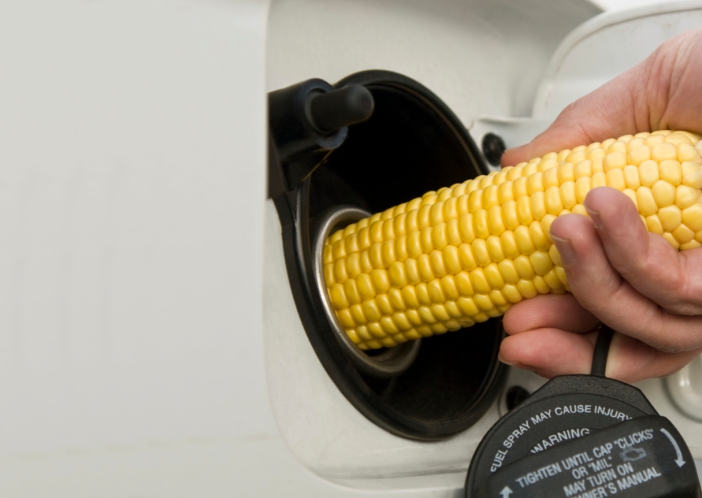The R Street Institute has produced two briefs on the Renewable Fuel Standard (RFS) detailing the consumer costs and negative environmental impacts.
A part of the Energy Policy Act of 2005, expanded through 2007’s Energy Independence and Security Act and administered by the Environmental Protection Agency (EPA), RFS required 36 billion gallons of “renewable” fuel sources such as ethanol be blended into gasoline and diesel fuel by 2022. EPA sets the volume obligations, which are specific targets for fuel refiners and blenders, evaluates the volumes, and may adjust them based on statutory factors and after a notice-and-comment rulemaking process.
For conventional renewable fuels, the volume has been flatlined at 15 billion gallons for 2023, 2024, and 2025, which is far lower than the benchmarks established by Congress in 2007. However, the EPA has proposed increasing these mandates to 24.02 billion gallons in 2026 and 24.46 billion gallons in 2027.
R Street estimates that the “additional ethanol consumed to comply with the RFS from 2010 to 2023 (i.e., the amount consumed beyond our baseline assumption that finished motor gasoline would contain 5 percent ethanol if the RFS had not been implemented) cost $214.5 billion, and purchasing this same energy as gasoline would have cost $168.5 billion, for a difference of $46 billion. If narrowing this timeframe to a standard 10-year analysis window from 2014 to 2023, the cost difference would be $28.1 billion.”
Further, they calculate that “approximately $152.8 billion was expended for RFS compliance from 2010 to 2023, representing a cost that refiners pass on to consumers in the form of higher pump prices. If narrowing this timeframe to a standard 10-year analysis window, from 2014 to 2023, $135.8 billion was expended. Thus, overall, we found that the combined increased cost of energy and compliance to consumers from 2010 to 2023 was $198.9 billion, or $163.8 billion from a 10-year analysis window of 2014 to 2023.”
R Street also finds RFS is extremely expensive and essentially useless to reduce carbon-dioxide (CO2) emissions. They calculate that the abatement cost of RFS per metric ton of CO2 emissions to be $1,464.27, which is 670 percent higher than the highest estimated “social cost” or carbon dioxide emissions during the Biden administration.
The second brief also points out that the passage of RFS directly contributed to a massive increase in the amount of land used to grow corn, which is the primary ingredient in ethanol. Approximately 40 percent of the entire corn crop grown in the United States goes toward ethanol production and, “to eke out more acreage for corn, growers turned to less productive ground—marginal areas where, without a new incentive, the cost and effort of crop production would have otherwise outweighed the value of the crop. In the first five years of the RFS, it is estimated that 1 million acres of environmentally sensitive lands previously set aside for conservation were put into production. More specifically, the very habitats that played an essential role in preventing runoff of soil and chemicals into waterways—wetlands and riparian zones—fell victim to the plow just when they were needed most.”
The loss of these environmental buffer areas has led to a spike in topsoil and fertilizer runoff into the Mississippi River watershed, leading to large rise in harmful algae blooms in the Great Lakes and the Gulf of Mexico, which can create “hypoxic areas or ‘dead zones’ that are dangerous to people and marine life.” The Gulf of Mexico is now home to the second-largest dead zone on the planet, about the size of the state of New Jersey, in 2024.
Proponents of RFS said its implementation would reduce CO2 emissions and decrease American dependence on foreign oil. The latter reason for RFS has been negated by the boom in oil and natural gas production caused by hydraulic fracturing and horizontal drilling, which began shortly after RFS was implemented, and the former was never reasonable to begin with. As R Street points out, biofuel production requires a great deal of land, disrupting the carbon-storing potential of the soil and at least partly offsetting emissions reductions that may have been achieved by substituting ethanol for regular gasoline.
The RFS imposes higher costs on consumers and small businesses, kills jobs, and harms both the economy and the environment. It is a useless program that Congress should repeal. Let consumers and the marketplace determine how much ethanol should be blended with fuel.
Heartland Impact can send an expert to your state to testify or brief your caucus; host an event in your state; or send you further information on a topic. Please don’t hesitate to contact us if we can be of assistance! If you have any questions or comments, contact Cameron Sholty, at csholty@heartlandimpact.org or 312/377- 4000.


